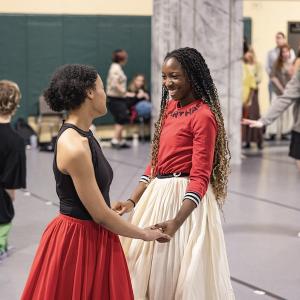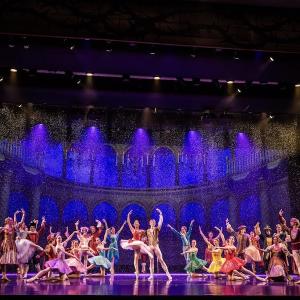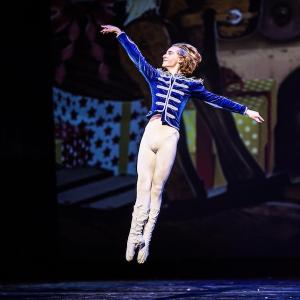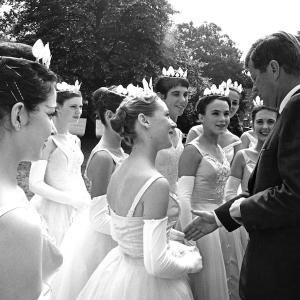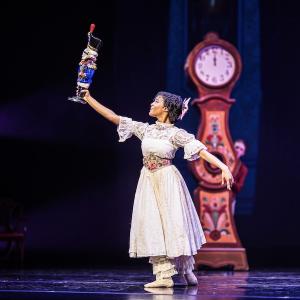Applications are still open for Arts Camp and Arts Academy. Programs fill quickly—submit your app today!
Cate Caplin’s golden wisdom
Ovation Award-winning choreographer and director Cate Caplin shares the history of musical theatre, the value of dance training, and the importance of the "in-betweens."
Nothing prepares you better for a successful musical theatre career than dancing and singing through the Golden Era. That’s especially true if you pay attention to what Interlochen Arts Camp Instructor of Theatre Cate Caplin (IAC/NMC 69-71) calls the “in-betweens”—how you relate to and treat those around you.
This is a master talking—an award-winning international dance champion, well-known choreographer, and theatre director. A past Interlochen Arts Camp student, Cate Caplin returns this summer to give back as the director of the High School Musical Theatre Golden Age Revue program.
If you work with Caplin, there are many pearls of wisdom to come. In a recent interview, Caplin provided a sample of what you can expect in her classroom—and many tips for a successful life on the stage.
How did your summers at Interlochen as a dancer impact your own training and career?
I was at Interlochen at a very young age. I've always been very disciplined about my training and workout, but I think being immersed in an intensive program surrounded by other young artists and new teachers challenging you in fresh, new ways is inspiring and nurturing.
What piece of advice were you given during your own training that you share with young artists?
It's not only the classes and direct training that is important, it's all the “in-betweens” and how you relate to and treat those around you, your attitude during class and rehearsals, your focus, and your professionalism. That's what will make people want to hire you and invite you on board again and again.
Whether it’s adagio, ballroom, swing, or modern how does understanding dance and movement improve an artist’s performance holistically?
Every creative discipline or professional field is affected positively by dance training: posture, breathing, energy level, ability to concentrate and focus, a refined attention to detail, learning to work in alignment with others, sensitivity to group dynamics, improved ability to collaborate and co-create, and last but not least, tenacity and endurance!
Many songs from the golden era are now ubiquitous with an actor’s audition cycle. Why is that, and what should young actors consider before entering the audition room with a song from that era?
This time period and style of music are the history and creative roots of musical theatre. In the same way that classical ballet is the foundation of all contemporary styles of dance, Golden Age music is the foundation of all musical theatre. Being a versatile performer is always the name of the game, and having that awareness of and training in the early classic styles of musical theatre will help to inform and enrich your appreciation of modern musicals while adding depth and context to all the work that arises.
What materials (films, documentaries, books, etc.) should young actors consume to help familiarize themselves with the Golden Era?
The genre began in the late 1920's with the first “talkie” film, The Jazz Singer, and there are many classic films and books about movie musicals that can be found simply by Googling! It's also good to research choreographer Agnes de Mille, who revolutionized Golden Age staged musicals with Rogers and Hammerstein classics like Oklahoma, Carousel, South Pacific, and The King & I.
Lerner & Lowe were also popular composers of this era, and they collaborated on Brigadoon (1947), My Fair Lady (1956), and Camelot (1960). Frank Loesser, who wrote Where's Charley (1948), Guys and Dolls (1950), Most Happy Fella (1956), and How to Succeed in Business Without Really Trying (1961) is also an important figure in the genre.
Many of these Broadway musicals were taken up by Hollywood within a few years of their Broadway debut, often with many of the original Broadway actors and much of the staging and choreography retained for the film versions. By now, Hollywood musicals fully adopted the integrated style of the Broadway musical, and musicals were some of the most successful films produced in Hollywood, by both critical and popular standards. Dance became a more integrated part of the Hollywood musical as well: In 1944, Jack Cole was hired to train and rehearse a permanent dance ensemble for Columbia Pictures. A lot of the history and resources can be found online, and the research takes off from there!
